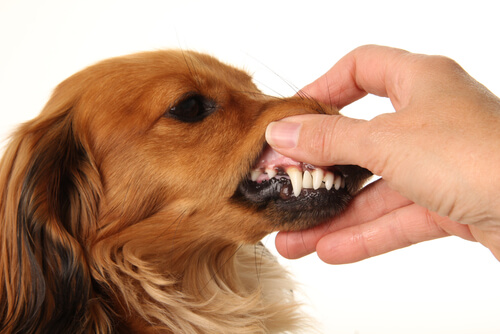How to Know How Old Your Dog Is

If you haven’t had your dog since it was a puppy you’ll have often wondered exactly how old your dog is and how you can tell exactly. This will help you decide how to feed them and what preventative care they might need and how to provide them with the happiest life possible.
Of course, your dog’s size, breed, general health, and activity level all affect how they age. For example, small dogs tend to live longer than large dogs, and, depending on their breed, they can age and mature at different rates.
So, if your dog wasn’t a puppy when they entered your life, how can you find out how old they are?
Fortunately, there are a few ways to estimate how old your dog is and we’ll be telling you about them in this article.
Check their teeth
The most reliable way to estimate your dog’s age is by examining their teeth. Puppies up to five weeks old will probably have no teeth, while those between five and eight weeks old will have needle-sharp temporary teeth.
Your puppy will start to get their permanent teeth around three to four months of age and they’ll remain white, bright and clean for the first year. After that, their teeth may begin to show a little wear and tear. At first, you will see stains and plaque right at the back of the mouth.
By around three years of age, most of their teeth will be slightly yellowed and have visible plaque. Dogs around five years old tend to have a lot of tartar, and their teeth aren’t as sharp or are even slightly worn, and here’s an increased risk of dental disease. And dogs older than 10 years will often have loose, cracked or missing teeth.

How old my dog is based on its coat
In a similar way to humans, most canines will start to turn a little gray as they age. Between the ages of 7 and 10, your dog is likely to develop some gray or white hair on the muzzle, chest, or hips.
However, the early appearance of gray fur isn’t necessarily a sign of aging and may actually be the result of stress or anxiety, as in humans.
How old a dog is according to their eyes
A dog’s eyes can show their age. As a dog ages, their eyes may begin to cloud over or develop a bit of discharge. This is a normal part of the aging process, which begins to appear when a dog is between six and eight years old.
However, it’s a good idea to talk to your veterinarian to make sure the change isn’t affecting your pet’s eyesight or causing discomfort. Some dogs will lose their vision completely or develop cataracts as they age.
Pay attention to their hearing
Vision isn’t the only sense that can change with aging. Younger dogs generally have very acute hearing. But you may notice that an older dog has trouble hearing when you approach and may not respond to your call. Your veterinarian can check for hearing loss and help you care for a dog who can no longer hear.
How old your dog is based on their muscles
You might also find out how old your dog is by looking at their muscle tone and body shape. Puppies tend to have soft, rounded bodies with little muscle tone. They’re also likely to have paws and ears that appear oversized.

Young and middle-aged dogs in good health tend to have some visible muscles and a sleek, defined shape. An older dog may have decreased muscle tone, carry a little more weight, or start to become a little bony.
Mobility and activity level
If your dog is younger, they’re likely to move easily and be eager to play or chase. As they get older they become less energetic and often begin to have difficulty going up or down the stairs, jumping, or running.
Older dogs may also show less interest in playing and prefer a nap on the couch rather than a run in the park. Keep an eye on your dog’s activity level and look for signs of stiffness or limited joint mobility.
Don’t forget genetics
While these methods can give you an idea of how old your dog is, not all canines age in the same way. Depending on their breed, medical history, diet and activity level, your dog may show signs of early aging, or may be very lively even into old age.
If you haven’t had your dog since it was a puppy you’ll have often wondered exactly how old your dog is and how you can tell exactly. This will help you decide how to feed them and what preventative care they might need and how to provide them with the happiest life possible.
Of course, your dog’s size, breed, general health, and activity level all affect how they age. For example, small dogs tend to live longer than large dogs, and, depending on their breed, they can age and mature at different rates.
So, if your dog wasn’t a puppy when they entered your life, how can you find out how old they are?
Fortunately, there are a few ways to estimate how old your dog is and we’ll be telling you about them in this article.
Check their teeth
The most reliable way to estimate your dog’s age is by examining their teeth. Puppies up to five weeks old will probably have no teeth, while those between five and eight weeks old will have needle-sharp temporary teeth.
Your puppy will start to get their permanent teeth around three to four months of age and they’ll remain white, bright and clean for the first year. After that, their teeth may begin to show a little wear and tear. At first, you will see stains and plaque right at the back of the mouth.
By around three years of age, most of their teeth will be slightly yellowed and have visible plaque. Dogs around five years old tend to have a lot of tartar, and their teeth aren’t as sharp or are even slightly worn, and here’s an increased risk of dental disease. And dogs older than 10 years will often have loose, cracked or missing teeth.

How old my dog is based on its coat
In a similar way to humans, most canines will start to turn a little gray as they age. Between the ages of 7 and 10, your dog is likely to develop some gray or white hair on the muzzle, chest, or hips.
However, the early appearance of gray fur isn’t necessarily a sign of aging and may actually be the result of stress or anxiety, as in humans.
How old a dog is according to their eyes
A dog’s eyes can show their age. As a dog ages, their eyes may begin to cloud over or develop a bit of discharge. This is a normal part of the aging process, which begins to appear when a dog is between six and eight years old.
However, it’s a good idea to talk to your veterinarian to make sure the change isn’t affecting your pet’s eyesight or causing discomfort. Some dogs will lose their vision completely or develop cataracts as they age.
Pay attention to their hearing
Vision isn’t the only sense that can change with aging. Younger dogs generally have very acute hearing. But you may notice that an older dog has trouble hearing when you approach and may not respond to your call. Your veterinarian can check for hearing loss and help you care for a dog who can no longer hear.
How old your dog is based on their muscles
You might also find out how old your dog is by looking at their muscle tone and body shape. Puppies tend to have soft, rounded bodies with little muscle tone. They’re also likely to have paws and ears that appear oversized.

Young and middle-aged dogs in good health tend to have some visible muscles and a sleek, defined shape. An older dog may have decreased muscle tone, carry a little more weight, or start to become a little bony.
Mobility and activity level
If your dog is younger, they’re likely to move easily and be eager to play or chase. As they get older they become less energetic and often begin to have difficulty going up or down the stairs, jumping, or running.
Older dogs may also show less interest in playing and prefer a nap on the couch rather than a run in the park. Keep an eye on your dog’s activity level and look for signs of stiffness or limited joint mobility.
Don’t forget genetics
While these methods can give you an idea of how old your dog is, not all canines age in the same way. Depending on their breed, medical history, diet and activity level, your dog may show signs of early aging, or may be very lively even into old age.
All cited sources were thoroughly reviewed by our team to ensure their quality, reliability, currency, and validity. The bibliography of this article was considered reliable and of academic or scientific accuracy.
This text is provided for informational purposes only and does not replace consultation with a professional. If in doubt, consult your specialist.








